Топик: Teddy Roosevelt
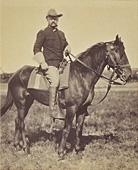
![]()
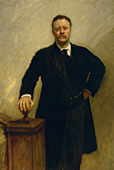
![]()
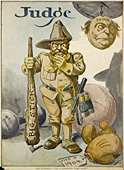
Theodore Roosevelt
Icon of the American Century
![]()
“The joy of living is his who has the heart to demand it.”
Theodore Roosevelt
executed: Magomedova Z.A.
examined: Akhmedova Z.G.
Makhachkala 2001
Contents
- Introduction page 3
- Maverick in the Making , 1882 – 1901 page 3
- Rough Rider in the White House , 1901 – 1909 page 7
- The Restless Hunter , 1909 – 1919 page 10
- Chronology of the Public Career of Theodore Roosevelt page 14
- Source page 15
Introduction
The life of Theodore Roosevelt (1858–1919)
was one of constant activity, immense energy, and enduring accomplishments. As
the twenty-sixth President of the United States, Roosevelt was the wielder of
the Big Stick, the builder of the Panama Canal, an avid conservationist, and the nemesis of the corporate trusts that threatened to monopolize
American business at the start of the century. His exploits as a Rough Rider in
the Spanish-American War and as a cowboy in the Dakota Territory were
indicative of his spirit of adventure and love of the outdoors. Reading and
hunting were lifelong passions of his; writing was a lifelong compulsion.
Roosevelt wrote more than three dozen books on topics as different as naval
history and African big game. Whatever his interest, he pursued it with
extraordinary zeal. "I always believe in going hard at everything,"
he preached time and again. This was the basis for living what he called the
"strenuous life," and he exhorted it for both the individual and the
nation.
and the nemesis of the corporate trusts that threatened to monopolize
American business at the start of the century. His exploits as a Rough Rider in
the Spanish-American War and as a cowboy in the Dakota Territory were
indicative of his spirit of adventure and love of the outdoors. Reading and
hunting were lifelong passions of his; writing was a lifelong compulsion.
Roosevelt wrote more than three dozen books on topics as different as naval
history and African big game. Whatever his interest, he pursued it with
extraordinary zeal. "I always believe in going hard at everything,"
he preached time and again. This was the basis for living what he called the
"strenuous life," and he exhorted it for both the individual and the
nation.
Roosevelt's engaging personality enhanced his popularity. Aided by scores of photographers, cartoonists, and portrait artists, his features became symbols of national recognition; mail addressed only with drawings of teeth and spectacles arrived at the White House without delay. TR continued to be newsworthy in retirement, especially during the historic Bull Moose campaign of 1912, while pursuing an elusive third presidential term. He remains relevant today. This exhibition is a retrospective look at the man and his portraiture, whose progressive ideas about social justice, representative democracy, and America's role as a world leader have significantly shaped our national character.
Maverick in the Making , 1882 - 1901
Theodore Roosevelt was born on October 27, 1858, in a brownstone house on Twentieth Street in New York City. A re-creation of the original dwelling, now operated by the National Park Service, replicates the tranquility of Roosevelt's earliest years. His father, Theodore Roosevelt Sr., was a prosperous glassware merchant, and was one of the wealthy old Knickerbocker class, whose Dutch ancestors had been living on Manhattan Island since the 1640s. His mother, Martha Bulloch, was reputedly one of the loveliest girls to have been born in antebellum Georgia. Together the parents instilled in their eldest son a strong sense of family loyalty and civic duty, values that Roosevelt would himself practice, and would preach from the bully pulpit all of his adult life.
Unfortunately the affluence to which the young Theodore grew accustomed could do little to improve the state of his fragile health. He was a sickly, underweight child, hindered by poor eyesight. Far worse, however, were the life threatening attacks of asthma he had to endure until early adulthood. To strengthen his constitution, he lifted dumbbells and exercised in a room of the house converted into a gymnasium. He took boxing lessons to defend himself and to test his competitive spirit. From an early age he never lacked energy or the will to improve himself physically and mentally. He was a voracious reader and writer; his childhood diaries reveal much about his interests and the quality of his expanding mind. Natural science, ornithology, and hunting were early hobbies of his, which became lifelong.
In the fall of 1876, Roosevelt entered Harvard University. By the time he graduated magna cum laude, he was engaged to be married to a beautiful young lady named Alice Lee. The wedding took place on Roosevelt's twenty-second birthday. Amid the intense happiness he experienced during his first year of marriage, he laid the foundations of his historic public career. "I rose like a rocket," he said years later. Ironically, when he chartered his own path for public office--the White House in 1912--he failed bitterly. When others had selected him--as they did for the New York Assembly in 1881, for the governorship in 1898, and for the vice presidency in 1900--his election was almost a foregone conclusion. Politics aside, Roosevelt shaped and molded his life as much as any person could possibly do. He could not control fate, however. On Valentine's Day, 1884, his mother died of typhoid fever and his wife died of Bright's disease, two days after giving birth to a daughter, Alice Lee. Amidst this personal trauma, Theodore Roosevelt was on the verge of becoming a national presence.
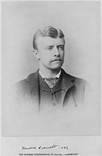
Between 1882 and 1884, Theodore Roosevelt represented the Twenty-first District of New York in the state legislative assembly in Albany. An 1881 campaign broadside noted that the young Republican candidate was "conspicuous for his honesty and integrity," qualities not taken for granted in a city run by self-serving machine politicians. This was the start of Roosevelt's long career as a political reformer.
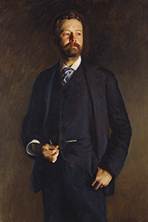
Roosevelt's political alliance with Henry Cabot Lodge of Massachusetts began in 1884, when the two were delegates to the Republican National Convention in Chicago. In time, both men would become leaders of the Republican Party. Their extensive mutual correspondence is an insightful record of shared interests and American idealism at the turn of the twentieth century. After serving in the United States House of Representatives for six years, Lodge became a senator in 1893 and retained his seat for the rest of his life. Like Roosevelt, Lodge was an advocate of civil service reform (he recommended Roosevelt to be a commissioner in 1889), a strong navy, the Panama Canal, and pure food and drug legislation. A specialist in foreign affairs, Lodge acted as one of Roosevelt's principal advisers during his presidency. Yet Lodge did not support many of Roosevelt's progressive reforms—women's suffrage, for instance—and he refused to endorse his friend in the Bull Moose campaign of 1912.
Love of adventure and the great outdoors, especially in the West, were the bonds that sealed the friendship between Theodore Roosevelt and Frederic Remington. "I wish I were with you out among the sage brush, the great brittle cottonwoods, and the sharply-channeled barren buttes," Roosevelt wrote to the western artist in 1897 from Washington. After the death of his wife Alice Lee in 1884, Roosevelt moved temporarily to the Bad Lands in the Dakota Territory, where he owned two cattle ranches. In 1888, Century Magazine published a series of articles about the West written by Roosevelt and illustrated by Remington. In a May article, Roosevelt told the story of his daring capture of three thieves who had stolen a boat from his Elkhorn Ranch. Remington depicted their capture in this painting.
Jacob Riis was a valuable friend and source of information for Roosevelt when he became a New York City police commissioner in the spring of 1895. As a police reporter for the New York Evening Sun, Riis understood the reforms needed within the police department, as well as the evils in the slums, which he frequented to gather stories. Riis was successful in awakening public awareness to the plight of New York's tenement population, especially the children, in several books, including his classic How the Other Half Lives. In 1904 Riis published a biography of his good friend, with whom he used to walk the streets of New York, titled Theodore Roosevelt: The Citizen.
 I have
"developed a playmate in the shape of Dr. Wood of the Army, an Apache
campaigner and graduate of Harvard, two years later than my class,"
Roosevelt wrote from Washington in 1897. "Last Sunday he fairly walked me
down in the course of a scramble home from Cabin John Bridge down the other
side of the Potomac over the cliffs." Theodore Roosevelt and Leonard
Wood liked each other from their first meeting that spring. Both were
robust and athletic, and both, from the vantage points of their respective
jobs—Roosevelt as assistant secretary of the navy, and Wood as an army officer
(and the physician of President and Mrs. William McKinley)—took a belligerent
attitude toward Spain with respect to Cuba. When Roosevelt was offered the
chance to raise a regiment of volunteer cavalry, he in turn recruited the more
experienced Wood to be the regiment's colonel and commander. After the war in
Cuba, Wood remained as military governor of Santiago, and shortly thereafter
was appointed to administer to the affairs of the entire island.
I have
"developed a playmate in the shape of Dr. Wood of the Army, an Apache
campaigner and graduate of Harvard, two years later than my class,"
Roosevelt wrote from Washington in 1897. "Last Sunday he fairly walked me
down in the course of a scramble home from Cabin John Bridge down the other
side of the Potomac over the cliffs." Theodore Roosevelt and Leonard
Wood liked each other from their first meeting that spring. Both were
robust and athletic, and both, from the vantage points of their respective
jobs—Roosevelt as assistant secretary of the navy, and Wood as an army officer
(and the physician of President and Mrs. William McKinley)—took a belligerent
attitude toward Spain with respect to Cuba. When Roosevelt was offered the
chance to raise a regiment of volunteer cavalry, he in turn recruited the more
experienced Wood to be the regiment's colonel and commander. After the war in
Cuba, Wood remained as military governor of Santiago, and shortly thereafter
was appointed to administer to the affairs of the entire island.
John Singer Sargent painted this portrait of Wood in 1903, when he went to Washington to do the official portrait of President Roosevelt. Sargent recalled then that the two veteran Rough Riders enjoyed competing against each other with fencing foils.
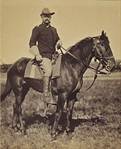 After
his return from the war in Cuba, Colonel Roosevelt posed for this photograph at
Montauk, Long Island, shortly before his First Volunteer Cavalry Regiment was
mustered out of service in September 1898. Later, in a letter to sculptor James
E. Kelly—who like Frederick MacMonnies sculpted a statuette of the Rough Rider
upon a horse—Roosevelt described in detail how he looked and dressed in the
war. Unlike his image here, he said, "In Cuba I did not have the side of
my hat turned up."
After
his return from the war in Cuba, Colonel Roosevelt posed for this photograph at
Montauk, Long Island, shortly before his First Volunteer Cavalry Regiment was
mustered out of service in September 1898. Later, in a letter to sculptor James
E. Kelly—who like Frederick MacMonnies sculpted a statuette of the Rough Rider
upon a horse—Roosevelt described in detail how he looked and dressed in the
war. Unlike his image here, he said, "In Cuba I did not have the side of
my hat turned up."
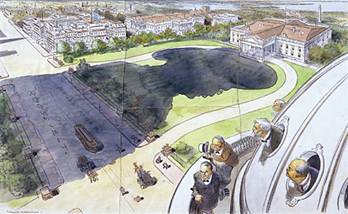
Theodore Roosevelt emerged from the Spanish-American War a national hero. His military fame now enhanced his reputation as a reform politician in his home state of New York, where he was nominated to run for the governorship that fall of 1898.
This cartoon appeared in Judge, October 29, 1898, just prior to Roosevelt's successful election, and predicted his ultimate political destiny, the White House.
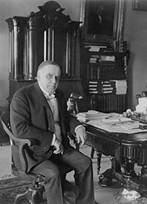 President William
McKinley represented the status quo for most Americans at the turn of the
century. By and large, they were comfortable with him in the White House. As
the standard bearer of the Republican Party, he was an unassuming bulwark of
conservatism. He stood for the gold standard, for protective tariffs, and of
course for a strong national defense during the Spanish-American War.
McKinley's personal attributes were affability and constancy, not dynamism and
originality. Politically he was a follower and not a reformer, like Roosevelt.
If the idea of having TR on the ticket as Vice President seemed at odds with
the President's relaxed style, it was perfectly like Mckinley to go along with
what the party and the people wanted. He never admitted to sharing the fears of
his good friend and political advisor, Ohio Senator Marcus Hanna, who was also
chairman of the national Republican committee. For Hanna, Roosevelt was too
young, too inexperienced and too much of a maverick. He could not help but
think: What if McKinley should die in office?
President William
McKinley represented the status quo for most Americans at the turn of the
century. By and large, they were comfortable with him in the White House. As
the standard bearer of the Republican Party, he was an unassuming bulwark of
conservatism. He stood for the gold standard, for protective tariffs, and of
course for a strong national defense during the Spanish-American War.
McKinley's personal attributes were affability and constancy, not dynamism and
originality. Politically he was a follower and not a reformer, like Roosevelt.
If the idea of having TR on the ticket as Vice President seemed at odds with
the President's relaxed style, it was perfectly like Mckinley to go along with
what the party and the people wanted. He never admitted to sharing the fears of
his good friend and political advisor, Ohio Senator Marcus Hanna, who was also
chairman of the national Republican committee. For Hanna, Roosevelt was too
young, too inexperienced and too much of a maverick. He could not help but
think: What if McKinley should die in office?
Rough Rider in the White House , 1901 - 1909
No
event had a more profound effect on Theodore Roosevelt's political career than 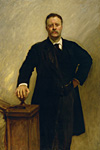 the assassination of President William
McKinley in September 1901. At the age of forty-two, Vice President Theodore
Roosevelt took the oath of office, becoming the youngest President of the
United States before or since. From the start, Roosevelt was committed to
making the government work for the people, and in many respects, the people
never needed government more. The post-Civil War industrial revolution had
generated enormous wealth and power for the men who controlled the levers of
business and capital. Regulating the great business trusts to foster fair
competition without socializing the free enterprise system would be one of
Roosevelt's primary concerns. The railroads, labor, and the processed food
industry all came under his scrutiny. Although the regulations he implemented
were modest by today's standards, collectively they were a significant first step
in an age before warning labels and consumer lawsuits.
the assassination of President William
McKinley in September 1901. At the age of forty-two, Vice President Theodore
Roosevelt took the oath of office, becoming the youngest President of the
United States before or since. From the start, Roosevelt was committed to
making the government work for the people, and in many respects, the people
never needed government more. The post-Civil War industrial revolution had
generated enormous wealth and power for the men who controlled the levers of
business and capital. Regulating the great business trusts to foster fair
competition without socializing the free enterprise system would be one of
Roosevelt's primary concerns. The railroads, labor, and the processed food
industry all came under his scrutiny. Although the regulations he implemented
were modest by today's standards, collectively they were a significant first step
in an age before warning labels and consumer lawsuits.
Internationally, America was on the threshold of world leadership. Acquisition of the Philippines and Guam after the recent war with Spain expanded the nation's territorial borders almost to Asia. The Panama Canal would only increase American trade and defense interests in the Far East, as well as in Central and South America. In an age that saw the rise of oceanic steamship travel, the country's sense of isolation was on the verge of suddenly becoming as antiquated as yardarms and sails.
A conservative by nature, Roosevelt was progressive in the way he addressed the nation's problems and modern in his view of the presidency. If the people were to be served, according to him, then it was incumbent upon the President to orchestrate the initiatives that would be to their benefit and the nation's welfare. Not since Abraham Lincoln, and Andrew Jackson before him, had a President exercised his executive powers as an equal branch of government. If the Constitution did not specifically deny the President the exercise of power, Roosevelt felt at liberty to do so. "Is there any law that will prevent me from declaring Pelican Island a Federal Bird Reservation? . . .Very well, then I so declare it!" By executive order in March 1903, he established the first of fifty-one national bird sanctuaries. These and the national parks and monuments he created are a part of his great legacy.
Theodore Roosevelt's dynamic view of the presidency infused vigor into a branch of government that traditionally had been ceremonial and sedate. His famous "Tennis Cabinet" was indicative of how he liked to work. Riding and hiking were daily pastimes; one senator jested that anyone wishing to have influence with the President would have to buy a horse. When the press could keep pace with him, it reveled in his activities, making him the first celebrity of the twentieth century. His spectacled image adorned countless magazine covers before beauty, sex, and scandal became chic. This image of Roosevelt by Peter Juley appeared on the cover of Harper's Weekly, July 2, 1904.
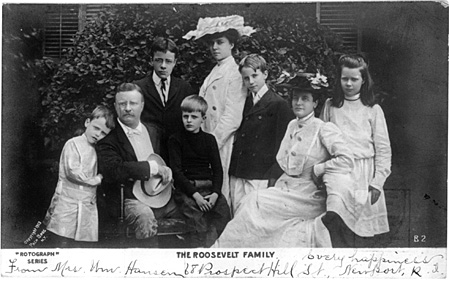
(Left to right):
Quentin (1897-1918), Theodore (1858-1919), Theodore Jr. (1887-1944), Archibald
(1894-1979),Alice Lee (1884-1980), Kermit (1889-1943), Edith Kermit
(1861-1948),
and Ethel Carow (1891-1977)
Like Roosevelt himself, the first family was young, energetic, and a novelty in the White House. Public interest in them was spontaneous, as pictures of Theodore, Edith, and their six children began appearing in newspapers and magazines. For once in history, the executive mansion acquired aspects of a normal American home, complete, with roller skates, bicycles, and tennis racquets.
 Theodore
Roosevelt's eldest child, Alice Lee, was an impressionable teenager when
the family moved into the White House in 1901. High-spirited and defiant by
nature, she enjoyed pushing the limits of decorum, while competing for her
father's attention. Naturally she was a favorite of the press, which called her
Princess Alice. Stories about her antics, her favorite color, a blue-gray
dubbed "Alice blue," and her cast of acquaintances filled the
newspapers. She smoked in public, bet at the racetrack, and was caught speeding
in her red runabout by the Washington police. Photographs of her connote the
classic Gibson Girl and suggest an air of youthful haughtiness. In 1906, she
married Nicholas Longworth, a Republican congressman from Ohio. He was
fifteen years her senior, short and bald, and something of a bon vivant. Their
White House wedding was the most talked-about social event of the Roosevelt
years.
Theodore
Roosevelt's eldest child, Alice Lee, was an impressionable teenager when
the family moved into the White House in 1901. High-spirited and defiant by
nature, she enjoyed pushing the limits of decorum, while competing for her
father's attention. Naturally she was a favorite of the press, which called her
Princess Alice. Stories about her antics, her favorite color, a blue-gray
dubbed "Alice blue," and her cast of acquaintances filled the
newspapers. She smoked in public, bet at the racetrack, and was caught speeding
in her red runabout by the Washington police. Photographs of her connote the
classic Gibson Girl and suggest an air of youthful haughtiness. In 1906, she
married Nicholas Longworth, a Republican congressman from Ohio. He was
fifteen years her senior, short and bald, and something of a bon vivant. Their
White House wedding was the most talked-about social event of the Roosevelt
years.
 At the invitation of the first family, John Singer
Sargent was a White House guest for a week in the middle of February 1903,
while he painted a portrait of the President. For Sargent, the foremost
Anglo-American portraitist of his era, the experience was vexing in many
respects. Particularly, Sargent found the President's strong will daunting from
the start. The choice of a suitable place to paint, where the lighting was
good, tried Roosevelt's patience. No room on the first floor agreed with the
artist. When they began climbing the staircase, Roosevelt told Sargent he did
not think the artist knew what he wanted. Sargent replied that he did not think
Roosevelt knew what was involved in posing for a portrait. Roosevelt, who had
just reached the landing, swung around, placing his hand on the newel and said,
"Don't I!" Sargent saw his opportunity and told the President not to
move; this would be the pose and the location for the sittings. Still, over the
next few days Sargent was frustrated by the President's busy schedule, which
limited their sessions to a half-hour after lunch. Sargent would have liked to
have had more time. Nevertheless, Roosevelt considered the portrait a complete
success. He liked it immensely, and continued to favor it for the rest of his
life. Commissioned by the federal government, Sargent's Roosevelt
is the official White House portrait of the twenty-sixth President.
At the invitation of the first family, John Singer
Sargent was a White House guest for a week in the middle of February 1903,
while he painted a portrait of the President. For Sargent, the foremost
Anglo-American portraitist of his era, the experience was vexing in many
respects. Particularly, Sargent found the President's strong will daunting from
the start. The choice of a suitable place to paint, where the lighting was
good, tried Roosevelt's patience. No room on the first floor agreed with the
artist. When they began climbing the staircase, Roosevelt told Sargent he did
not think the artist knew what he wanted. Sargent replied that he did not think
Roosevelt knew what was involved in posing for a portrait. Roosevelt, who had
just reached the landing, swung around, placing his hand on the newel and said,
"Don't I!" Sargent saw his opportunity and told the President not to
move; this would be the pose and the location for the sittings. Still, over the
next few days Sargent was frustrated by the President's busy schedule, which
limited their sessions to a half-hour after lunch. Sargent would have liked to
have had more time. Nevertheless, Roosevelt considered the portrait a complete
success. He liked it immensely, and continued to favor it for the rest of his
life. Commissioned by the federal government, Sargent's Roosevelt
is the official White House portrait of the twenty-sixth President.
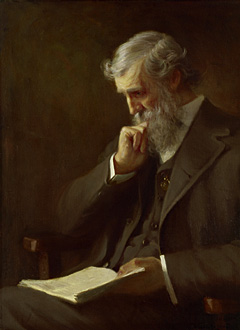
On an extended visit to the West in the spring of 1903, President Roosevelt sought the company of naturalists John Burroughs and John Muir. With Burroughs, Roosevelt camped in Yellowstone Park for two weeks, and with Muir he explored the wonders of the Yosemite Valley and had his picture taken in front of a giant sequoia tree in the Mariposa Grove. Roosevelt's visit was an opportunity for Muir to be able to impress upon the President the need for immediate preservation measures, especially for the giant forests. In 1908, Roosevelt paid tribute to Muir by designating Muir Woods, a redwood forest north of San Francisco, a national monument.
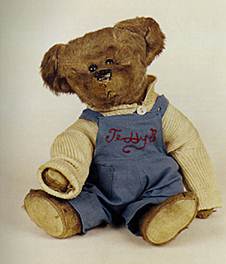 A hunting trip
President Roosevelt made into the swamps of Mississippi in 1902 became
legendary when he refused to shoot an exhausted black bear, which had been run
down by a pack of hounds and roped to a tree. Although the incident was
reported in the local press, Clifford K. Berryman, a staff artist for the Washington
Post, made it memorable on November 16 with a small front-page cartoon
titled "Drawing the Line in Mississippi." Roosevelt is shown holding
a rifle, but refusing to shoot the bedraggled bear. The bear, however, received
no executive clemency; Roosevelt ordered someone else to put the creature out
of its misery. Clifford Berryman elected to keep the bear alive in his
cartoons, and it evolved, ever more cuddly, as a companion to Roosevelt,
ultimately spawning the Teddy Bear craze.
A hunting trip
President Roosevelt made into the swamps of Mississippi in 1902 became
legendary when he refused to shoot an exhausted black bear, which had been run
down by a pack of hounds and roped to a tree. Although the incident was
reported in the local press, Clifford K. Berryman, a staff artist for the Washington
Post, made it memorable on November 16 with a small front-page cartoon
titled "Drawing the Line in Mississippi." Roosevelt is shown holding
a rifle, but refusing to shoot the bedraggled bear. The bear, however, received
no executive clemency; Roosevelt ordered someone else to put the creature out
of its misery. Clifford Berryman elected to keep the bear alive in his
cartoons, and it evolved, ever more cuddly, as a companion to Roosevelt,
ultimately spawning the Teddy Bear craze.
The Restless Hunter , 1909 - 1919
Only once in American history had a President vacated the White House and then returned to it again as President. This had been Grover Cleveland's unique destiny in 1893. That this had occurred within recent memory, and to a politician in whose footsteps Roosevelt had followed as governor of New York and finally as President, must have given Roosevelt reason to pause as he himself became a private citizen again in March 1909. He was only fifty years old, the youngest man to leave the executive office. Cleveland had been just eighteen months older when he temporarily yielded power to Benjamin Harrison in 1889. For the record, Roosevelt claimed that he was through with politics. This was the only thing he could have said as William Howard Taft, his successor, waited in the wings. Theodore Roosevelt had enjoyed being President as much as any person possibly could. Filling the post-White House vacuum would require something big and grand, and with that in mind, Roosevelt planned his immediate future. The prospect of a yearlong safari in Africa brightened for him what otherwise would have been the dreary prospect of retirement. It "will let me down to private life without that dull thud of which we hear so much," he wrote.
Aided by several British experts, Roosevelt oversaw every preparation: itinerary, gear and clothing, food and provisions, weapons, personnel, and expenses. He had been an avid naturalist and hunter since the days of his youth. Because he was genuinely interested in the African fauna, he arranged for his safari to be as scientific as possible, and enticed the Smithsonian Institution to join the expedition by offering to contribute extensively to its fledgling collection of wildlife specimens. Roosevelt invited his son, Kermit, along for companionship, if the lad would be willing to interrupt his first year of studies at Harvard. Kermit needed no persuading.
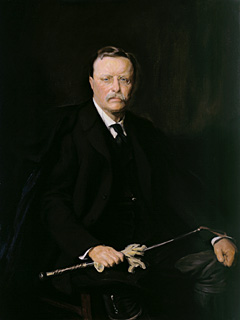
By President Roosevelt's last year in the White House, he had long grown tired of requests to sit to photographers and portrait painters. Only as a favor to an old friend from England, Arthur Lee, did he agree to sit for a portrait by the accomplished Hungarian born artist, Philip A. de Laszlo. The sittings took place in the spring of 1908, about which Roosevelt reported enthusiastically to Lee. "I took a great fancy to Laszlo himself," he wrote, "and it is the only picture which I really enjoyed having painted." Laszlo encouraged the President to invite guests to the sittings to keep Roosevelt entertained. "And if there weren't any visitors," said Roosevelt, "I would get Mrs. Laszlo, who is a trump, to play the violin on the other side of the screen." When the painting was finished, Roosevelt said that he liked it "better than any other."
Ten years later, however, Roosevelt expressed a preference for Sargent's portrait, done in 1903, which he thought had "a singular quality, a blend of both the spiritual and the heroic." Still he thought that Mrs. Roosevelt favored Laszlo's more relaxed image, a trademark of the artist's ingratiating style.
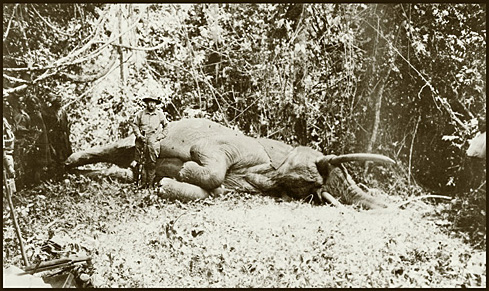
Three weeks after Theodore Roosevelt left the White House in March 1909, he embarked with his son, Kermit, upon an African safari, lasting nearly a year. He had always wanted to hunt the big game of Africa, but he also wanted his expedition to be as scientific as possible. With this in mind, he invited the Smithsonian Institution to take part, and promised to give the Institution significant animal trophies, representing dozens of new species for its collections. Roosevelt himself made extensive scientific notes about his African expedition. For instance, he was keenly interested in the flora of Africa, and recorded the dietary habits of the animals he killed after examining the contents of their stomachs.
While on safari, Roosevelt wrote extensively about his African adventure. Scribner's magazine was paying him $50,000 for a series of articles, that appeared in 1910 as a book, African Game Trails. This photograph of Roosevelt with a bull elephant was used as an illustration.

In March 1910, Roosevelt ended his eleven month African safari and, reunited with his wife, embarked on an extended tour of Europe. He accepted many invitations from national sovereigns and gave much anticipated lectures at the Sorbonne in Paris and at Oxford University in England. In Norway, he delivered finally his formal acceptance speech for having won the Nobel Peace Prize four years earlier. "I am received everywhere," he wrote, "with as much wild enthusiasm as if I were on a Presidential tour at home."
This cover of Harper's Weekly, June 18, 1910, was one of numerous graphic commentaries celebrating Roosevelt's return to the United States.
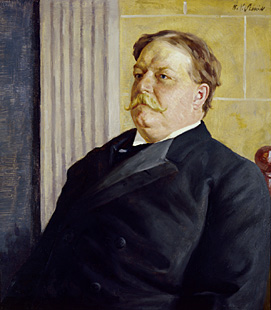 Supreme
Court Justice David J. Brewer used to jest that William Howard Taft was
the politest man in Washington, because he was perfectly capable of giving up
his seat on a streetcar to three ladies. Taft's amicable disposition it was
said that his laugh was one of the "great American institutions" was
the foremost quality that won Roosevelt's admiration. "I think he has the
most lovable personality I have ever come in contact with," said
Roosevelt. As governor general of the Philippines and then as secretary of war,
Taft proved to be a troubleshooter in Roosevelt's cabinet. His longtime
ambition had been to someday sit with Justice Brewer on the bench of the
Supreme Court. Taft would ultimately succeed to the Court, but not before
Roosevelt pegged him to be his successor. "Taft will carry on the work
substantially as I have carried it on," predicted Roosevelt. "His
policies, principles, purposes and ideals are the same as mine." Yet when
Taft later proved to be his own person, Roosevelt was distraught. Taft failed
to convey the spirit of progressivism to which Roosevelt was ever leaning.
"There is no use trying to be William Howard Taft with Roosevelt's
ways," he bemoaned, "our ways are different."
Supreme
Court Justice David J. Brewer used to jest that William Howard Taft was
the politest man in Washington, because he was perfectly capable of giving up
his seat on a streetcar to three ladies. Taft's amicable disposition it was
said that his laugh was one of the "great American institutions" was
the foremost quality that won Roosevelt's admiration. "I think he has the
most lovable personality I have ever come in contact with," said
Roosevelt. As governor general of the Philippines and then as secretary of war,
Taft proved to be a troubleshooter in Roosevelt's cabinet. His longtime
ambition had been to someday sit with Justice Brewer on the bench of the
Supreme Court. Taft would ultimately succeed to the Court, but not before
Roosevelt pegged him to be his successor. "Taft will carry on the work
substantially as I have carried it on," predicted Roosevelt. "His
policies, principles, purposes and ideals are the same as mine." Yet when
Taft later proved to be his own person, Roosevelt was distraught. Taft failed
to convey the spirit of progressivism to which Roosevelt was ever leaning.
"There is no use trying to be William Howard Taft with Roosevelt's
ways," he bemoaned, "our ways are different."
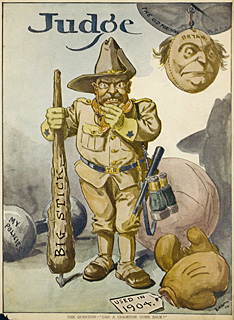 Coaxed by his political admirers, and personally
dissatisfied with what he considered to be President Taft's lack of leadership,
Roosevelt announced early in 1912 that he would run for a historic third
presidential term, if the GOP nomination were tendered to him. This was a
monumental decision on his part, one he made contrary to his own established
beliefs in the tradition of party loyalty, and without the full backing of
party leaders. Roosevelt was counting on winning the support of the people, and
was successful in those states that had direct primaries. But in June, at the
Republican convention in Chicago, the party machine wrested control of the
proceedings and nominated President Taft easily after the Roosevelt delegates
had walked out. This was the start of the Progressive Party, in which Roosevelt
proudly accepted the nomination. The press was especially happy to have him
back in the running. From the moment he declared, "My hat is in the
ring," he became the most visible, if not viable, candidate. Ultimately,
Roosevelt would beat Taft in the election, but he would lose to the Democratic
candidate, Woodrow Wilson. This cover of Judge, August 6, 1910,
raised "the question" from early on--"Can a champion come
back?"
Coaxed by his political admirers, and personally
dissatisfied with what he considered to be President Taft's lack of leadership,
Roosevelt announced early in 1912 that he would run for a historic third
presidential term, if the GOP nomination were tendered to him. This was a
monumental decision on his part, one he made contrary to his own established
beliefs in the tradition of party loyalty, and without the full backing of
party leaders. Roosevelt was counting on winning the support of the people, and
was successful in those states that had direct primaries. But in June, at the
Republican convention in Chicago, the party machine wrested control of the
proceedings and nominated President Taft easily after the Roosevelt delegates
had walked out. This was the start of the Progressive Party, in which Roosevelt
proudly accepted the nomination. The press was especially happy to have him
back in the running. From the moment he declared, "My hat is in the
ring," he became the most visible, if not viable, candidate. Ultimately,
Roosevelt would beat Taft in the election, but he would lose to the Democratic
candidate, Woodrow Wilson. This cover of Judge, August 6, 1910,
raised "the question" from early on--"Can a champion come
back?"
Theodore Roosevelt once declared himself to be "as strong as a bull moose." The appellation stuck and the moose became the popular symbol for the Progressive Party under Roosevelt. This cartoon depicting the mascots of the major parties appeared in Harper's Weekly, July 20, 1912, just before the "Bull Moose" convention opened in Chicago.
Chronology of the Public Career of Theodore Roosevelt
1882-1884 - New York State Assemblyman
1889-1895 - United States Civil Service Commissioner
1895-1897 - New York City Police Commissioner
1897-1898 - Assistant Secretary of the Navy
1898 - Rough Rider
1899-1900 - Governor of New York
1901- Vice President of the United States
1901-1909 - President of the United States
Source
1. www.yahoo.com
2. http://www.npg.si.edu/exh/roosevelt/index.php